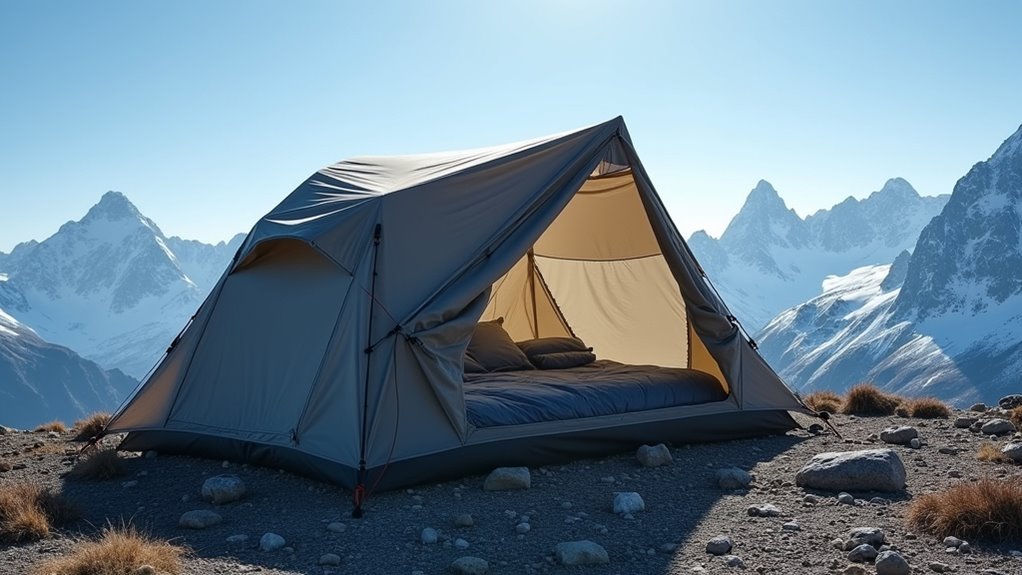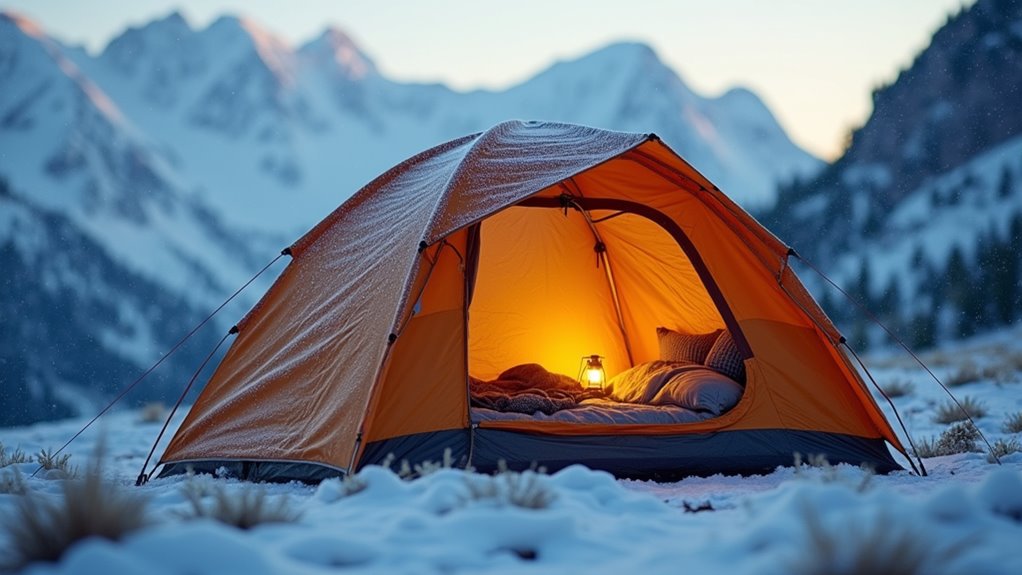What Makes A Tent A 4 Season Tent
This post contains affiliate links. As an Amazon Associate, we earn from qualifying purchases.
A 4-season tent is designed to endure harsh weather conditions, providing superior wind resistance, snow shedding, and insulation compared to other tents. It features a sturdy dome frame with crossing poles, heavy-duty fabric for durability and heat retention, and reinforced seams to enhance weather protection. Additionally, well-placed vents help manage humidity, and extra space accommodates gear, making it ideal for winter excursions. Further explanation and detailed features of specific models will be discussed later in the article for those interested in learning more.
Essential Facts in 30 Seconds
- 4-season tents have strong pole structures with crossing poles for stability in wind and snow.
- They use heavy-duty materials like cotton canvas or Dyneema for durability and weather resistance.
- Insulation helps retain heat, making them about 10°F warmer than 3-season tents.
- Ventilation is designed to minimize condensation while keeping warmth, using adjustable vents and double walls.
- Larger size and vestibules offer extra space for gear storage, suitable for winter trips.
Structural Design and Stability Features
A 4-season tent stands strong in tough weather. The pole design shapes its strength. Many tents use crossing poles to build a dome frame. This dome resists strong winds and heavy snow. Poles made from alloy are tough. They bend less than regular poles. Additionally, regular waterproofing treatment is essential for maintaining the tent’s protective capabilities against moisture.
The tent’s shape helps too. Dome and A-frame shapes push snow off. Round shapes stop snow from piling up. A-frames keep the tent tight during wind. These tents can stand on their own. They don’t need many ropes or stakes to hold up.
Snow flaps stop snow from blowing inside. Multiple guy-out points add extra strength. These parts help the tent fight wild weather. Knowing these features keeps you safe and cozy. Your next trip will be easier with this knowledge. Additionally, a rainfly can significantly enhance the tent’s waterproof capabilities during heavy rain.
Materials and Construction Quality

Strong materials and good construction make a 4-season tent last longer. Heavy-duty cotton canvas stands up well to rough weather. Nylon fabric is light and strong, especially with a protective coating. Dyneema costs more but offers top strength and waterproofing. Tent material choice plays a crucial role in overall performance and durability. Double-stitched seams keep the tent from tearing in strong winds. Reinforced corners stop damage during storms. These features help your tent stay safe and dry in tough conditions. Additionally, a high-quality tent floor material is essential for ensuring moisture protection and comfort during extended use.
Weather Resistance and Insulation Characteristics

4-season tents keep you safe and warm in harsh weather. They stand strong against hurricane-force winds because of their tough frames and extra poles. Rounded shapes help wind slide off and snow fall away, making the tent steady during storms. These tents hold about 10°F more heat than 3-season ones. They use less mesh, so less heat escapes and cold air stays out. Solid fabric panels zip over mesh areas to keep warmth inside. Double walls use breathable, waterproof fabrics to stop dampness and keep heat balanced. Additionally, a four-season tent is specifically designed to handle harsh winter conditions effectively.
Waterproof fabrics and sealed seams stop rain and wet snow from getting inside. Big rainflies cover more of the tent, keeping it dry and cozy in tough weather. Regularly testing waterproofing effectiveness helps ensure your tent remains in top condition for extreme cold and wet conditions. These features make 4-season tents perfect for extreme cold and wet conditions.
Ventilation and Condensation Control Mechanisms
Good ventilation in 4-season tents keeps you dry and cozy. Vents placed well control moisture and stop fog inside.
Adjustable vents let you change airflow and hold heat when needed. Zipper and drawstring vents give you easy ways to open or close air paths.
Double-wall tents trap air between layers, cutting dampness but still keeping warmth. Condensation curtains block moisture, so your space stays dry.
External vents push wet air out, cutting down inside dampness and making the tent stronger against weather.
These features work together to keep your tent fresh and comfy.
Size, Storage, and Usability Considerations
Size, storage, and ease of use matter for a 4-season tent. A 4-person tent usually has 60-70 square feet of floor space. This size fits 2-3 people and their gear comfortably. Bigger tents give extra room for gear without feeling cramped.
Storage space helps keep things tidy. Vestibules of 10-13 square feet work well to store wet boots and clothes. Inside, gear lofts and pockets hold small items neatly.
Tents must be easy to set up in tough weather. Lightweight aluminum poles make assembly quick on rocky or uneven ground. Tents with two or more doors allow easy entry and exit during storms.
Check the packed size and weight. Choose tents with compact poles and bags that carry easily. This makes winter trips less tiring and more fun.
Frequently Asked Questions
How Do I Choose the Right 4-Season Tent for My Needs?
Check the tent’s weight and how much gear it holds. Think about the weather you expect. Strong materials keep you safe in wind and snow. Good airflow stops inside air from feeling stuffy. Make sure setup is quick and easy. A sturdy tent lasts through tough trips. Comfort matters when storms hit hard.
Can I Use a 4-Season Tent in Summer?
A 4-season tent works in summer, but expect some heat inside. These tents use thick materials to block wind and snow. This makes them strong but traps heat. Ventilation is often limited, so air does not flow well. Inside temperatures can rise quickly, causing discomfort. For cooler camping, a lighter, 3-season tent usually feels better. Still, a 4-season tent protects well from bugs and sudden weather changes. Choose based on your comfort needs and weather conditions.
What Is the Average Lifespan of a 4-Season Tent?
A good 4-season tent lasts about 5 to 10 years with care. Harsh weather can wear it out faster. Using it often in snow, rain, or strong wind makes it weaker. Cleaning and drying the tent after trips help keep it strong. Store it in a cool, dry place to avoid damage. Small tears or broken zippers need fixing right away. Taking care of your tent saves money and keeps it safe for many adventures.
How Do I Maintain and Clean My 4-Season Tent?
Keep your 4-season tent clean and ready for use. Air it out after every trip to stop mold and smells. Use a soft cloth and mild soap to wipe dirt and stains. Avoid strong detergents; they can damage the fabric. Let the tent dry fully before packing it away. Store it in a cool, dry place to protect it from moisture. Regular care helps your tent last many seasons. Simple steps like these save money and keep your shelter safe in harsh weather.
Are 4-Season Tents More Expensive Than 3-Season Tents?
4-season tents cost more than 3-season tents. They use stronger materials and have tougher designs. These tents keep you safe in snow, wind, and cold weather. The higher price matches their better protection and durability. Many campers pay extra for this reliability in harsh conditions.
Conclusion
A four-season tent stands strong in tough weather. It handles winds up to 70 mph without breaking. Strong poles and tight seams keep the tent stable. The fabric must resist rain, snow, and cold. Good ventilation stops moisture inside the tent. This prevents frost and keeps air fresh. Pick tents with extra reinforcements and durable materials. These features protect you during storms or heavy snow. Knowing these facts helps you pick the right tent. Stay safe and warm on all your outdoor trips.
